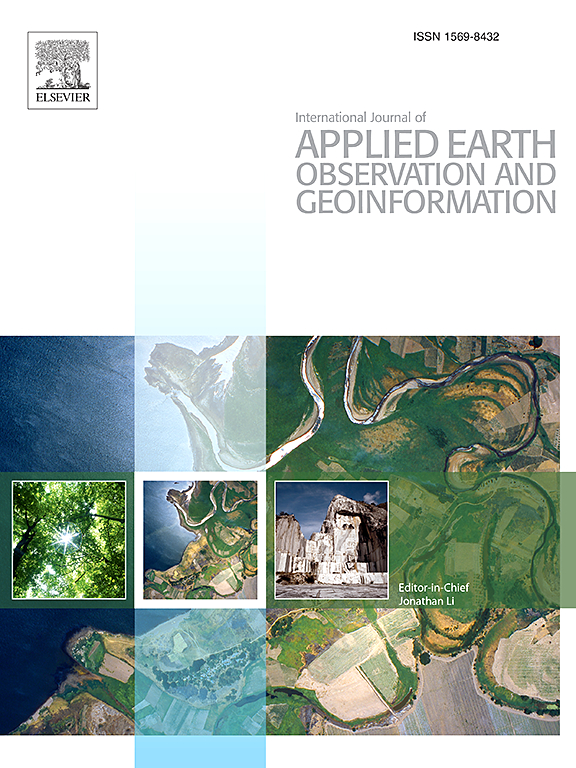基于多级特征融合和伪标记的半监督遥感场景分类方法
IF 7.6
Q1 REMOTE SENSING
International journal of applied earth observation and geoinformation : ITC journal
Pub Date : 2025-02-01
DOI:10.1016/j.jag.2024.104335
引用次数: 0
摘要
遥感影像(RSI)场景分类在土地覆盖制图、城市规划和环境监测等多种应用中发挥着关键作用。然而,传统的深度学习方法严重依赖于大量的标记数据,这些数据通常成本高昂且难以获取。半监督学习作为一种具有成本效益的替代方法出现,但现有方法往往忽略了遥感数据的复杂特征,如多尺度特征和复杂的空间模式,从而限制了它们有效应对这些挑战的能力。在本研究中,引入了一种新的场景半监督方法(SSSM),标志着网络架构和半监督技术的重大进步。SSSM框架的核心是多层次特征融合网络(MFFN),该网络经过精心设计,可以从不同尺度和位置的遥感数据中提取和整合复杂特征。为了优化伪标签的使用并最大限度地减少错误标记,提出了伪标签多级采样策略(PMLS),这是一种选择性地识别高质量伪标签以增强训练的概率方法。在三个基准数据集上进行的严格实验表明,SSSM方法显著提高了分类精度,与现有方法相比,在特定数据集上实现了3%-5%的提高。这一成就强调了MFFN设计和半监督策略在解决遥感场景分类复杂性方面的有效性。综上所述,本研究提出的mffn驱动伪标签框架为半监督遥感场景分类开辟了一个前沿和有前景的新方向。本文章由计算机程序翻译,如有差异,请以英文原文为准。

Improving semi-supervised remote sensing scene classification via Multilevel Feature Fusion and pseudo-labeling
Remote Sensing Image (RSI) scene classification plays a pivotal role in diverse applications such as land cover mapping, urban planning, and environmental monitoring. Traditional deep learning approaches, however, heavily rely on abundant labeled data, which is often costly and challenging to acquire. Semi-supervised learning emerges as a cost-effective alternative, yet existing methods frequently overlook the intricate characteristics of remote sensing data, such as multi-scale features and complex spatial patterns, thereby limiting their ability to effectively address these challenges. In this study, a novel Scene Semi-Supervised Method (SSSM) is introduced, marking a significant advancement in both network architecture and semi-supervised techniques. At the core of the SSSM framework lies the Multi-Level Feature Fusion Network (MFFN), meticulously designed to extract and integrate complex features from remote sensing data across diverse scales and locations. To optimize the utilization of pseudo-labels and minimize mislabeling, the Pseudo-Label Multi-Level Sampling strategy (PMLS) is proposed, a probabilistic approach that selectively identifies high-quality pseudo-labels to enhance training. Rigorous experiments conducted on three benchmark datasets reveal that the SSSM method significantly improves classification accuracy, achieving an increase of 3%–5% on a specific dataset compared to existing approaches. This accomplishment underscores the effectiveness of the MFFN design and the semi-supervised strategy in tackling the complexities of remote sensing scene classification. In summary, the MFFN-driven pseudo-label framework presented in this research pioneers a cutting-edge and promising new direction for semi-supervised remote sensing scene classification.
求助全文
通过发布文献求助,成功后即可免费获取论文全文。
去求助
来源期刊

International journal of applied earth observation and geoinformation : ITC journal
Global and Planetary Change, Management, Monitoring, Policy and Law, Earth-Surface Processes, Computers in Earth Sciences
CiteScore
12.00
自引率
0.00%
发文量
0
审稿时长
77 days
期刊介绍:
The International Journal of Applied Earth Observation and Geoinformation publishes original papers that utilize earth observation data for natural resource and environmental inventory and management. These data primarily originate from remote sensing platforms, including satellites and aircraft, supplemented by surface and subsurface measurements. Addressing natural resources such as forests, agricultural land, soils, and water, as well as environmental concerns like biodiversity, land degradation, and hazards, the journal explores conceptual and data-driven approaches. It covers geoinformation themes like capturing, databasing, visualization, interpretation, data quality, and spatial uncertainty.
 求助内容:
求助内容: 应助结果提醒方式:
应助结果提醒方式:


